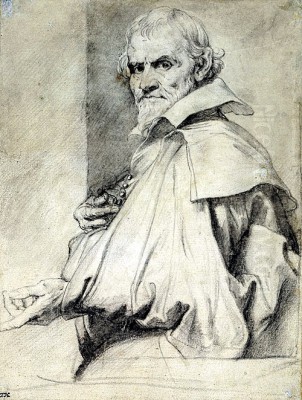
Orazio Gentileschi, born Orazio Lomi in Pisa in 1563 and passing away in London in 1639, stands as a pivotal figure in the Italian Baroque period. He was a contemporary and an early follower of the revolutionary Michelangelo Merisi da Caravaggio, yet he forged a distinct artistic identity characterized by a refined lyricism, exquisite color harmonies, and a sophisticated handling of light that softened Caravaggio's stark drama. His peripatetic career took him from Italy to the courts of France and England, making him an international conduit for Baroque artistic trends. This exploration delves into the life, artistic evolution, significant works, and enduring legacy of Orazio Gentileschi, a painter whose contributions continue to be celebrated for their technical brilliance and emotive power.
Early Life and Artistic Formation in Tuscany and Rome
Orazio Lomi was born into an artistic milieu in Pisa. His father, Giovanni Battista Lomi, was a Florentine goldsmith, and his elder half-brother, Aurelio Lomi, was a notable painter in Pisa and Florence, providing Orazio with his initial artistic grounding. Around 1576 or 1578, seeking broader opportunities, the young Orazio moved to Rome. It was here, in the bustling artistic center of Europe, that he would later adopt the surname Gentileschi, likely from an uncle.
His early years in Rome are somewhat obscure, but he is believed to have engaged in various decorative projects, typical for aspiring artists of the time. These early experiences would have exposed him to the prevailing late Mannerist style, characterized by elongated figures, artificial poses, and complex compositions. Artists like Cavalier d'Arpino (Giuseppe Cesari), a dominant figure in Rome before Caravaggio's ascent, would have represented the established artistic order. Orazio's initial works likely reflected these influences, though few securely attributed pieces from this very early period survive to give a clear picture of his pre-Caravaggesque style.
The Caravaggesque Revolution and Gentileschi's Roman Period
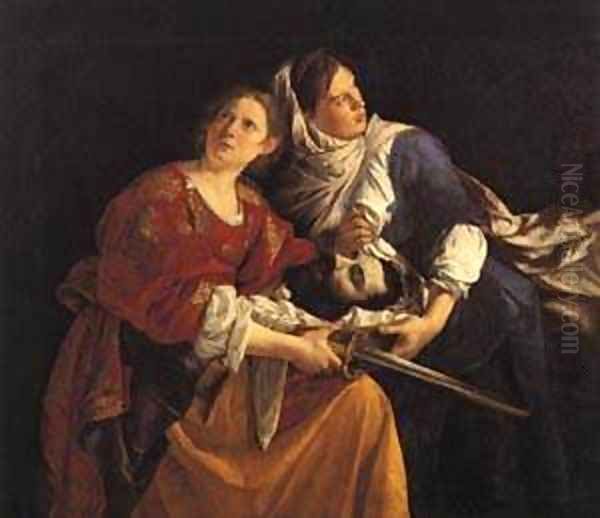
The arrival of Caravaggio in Rome in the early 1590s sent shockwaves through the artistic community. Caravaggio's uncompromising naturalism, his dramatic use of chiaroscuro (strong contrasts between light and dark), often termed tenebrism, and his depiction of religious scenes with figures drawn from everyday life, were revolutionary. Orazio Gentileschi, though older than Caravaggio by about eight years, was profoundly influenced by this new artistic language.
Gentileschi became one of the earliest and most significant artists to respond to Caravaggio's innovations. He formed a personal acquaintance with Caravaggio, and they were known to associate, even sharing props. This connection is documented, notably, in the records of a 1603 libel suit brought by the painter Giovanni Baglione against Caravaggio, Orazio Gentileschi, Onorio Longhi, and Filippo Trisegni, accusing them of circulating defamatory verses. This incident underscores their presence within the same often contentious Roman art circles.
During this Roman phase, Gentileschi began to incorporate Caravaggesque elements into his work. However, he did not merely imitate. Instead, he filtered Caravaggio's dramatic realism through his own Tuscan sensibility, which valued grace, clarity of form, and a more refined palette. While he adopted the strong lighting, his shadows are often less impenetrable, and his figures possess an elegance and a psychological subtlety that distinguishes his art. He collaborated with the landscape and perspective painter Agostino Tassi on several projects, including frescoes in the Palazzo Pallavicini-Rospigliosi (Casino delle Muse), where Gentileschi painted the figures within Tassi's architectural settings.
Masterworks of the Roman and Early Post-Roman Period
Several key works from this period illustrate Gentileschi's evolving style. David and Goliath (often dated around 1605-1607, National Gallery of Ireland, Dublin) showcases a clear debt to Caravaggio in its dramatic lighting and the naturalistic depiction of the young hero. However, the composition is more ordered, and David's figure possesses a certain grace.
Another significant work is Judith and Her Maidservant with the Head of Holofernes (c. 1608-1609, Wadsworth Atheneum, Hartford). While the theme was popular among Caravaggisti, Gentileschi's interpretation is less violent and more psychologically nuanced than many others. The rich fabrics and the interplay of light on surfaces demonstrate his growing mastery.
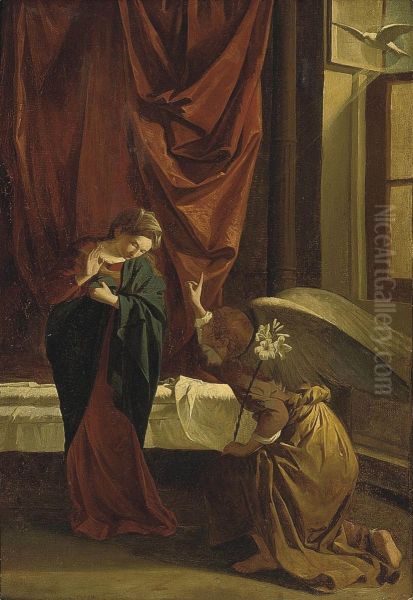
Saint Cecilia and an Angel (c. 1617/1618, or possibly a later version c. 1621-1627, National Gallery of Art, Washington D.C.) is a sublime example of his mature Roman style. The painting exudes a serene, lyrical quality. The angel's gentle interaction with Saint Cecilia, the delicate rendering of her features, and the luminous quality of the colors—especially the rich reds and blues—are hallmarks of Gentileschi's refined Caravaggism. The play of light on the velvet and satin draperies is particularly masterful, showcasing his skill in rendering textures.
Around 1610-1611, he also produced a powerful Saint Jerome, a subject favored for its potential for dramatic introspection and anatomical study, which allowed him to explore the expressive possibilities of the aged human form under strong light.
Artistic Maturity: The Marches, Genoa, and International Recognition
After his Roman period, Gentileschi's career took him to various Italian cities and eventually abroad. He worked in the Marches, notably in Fabriano, where he painted frescoes in the Cappella del Duomo (Valle Romita Polyptych altarpieces were earlier, by Gentile da Fabriano, not Orazio). His style continued to evolve, moving towards greater elegance and a brighter palette, though the foundational lessons of Caravaggio remained.
A particularly fruitful period was his stay in Genoa from approximately 1621 to 1624. Genoa was a wealthy maritime republic with sophisticated patrons. Here, Gentileschi produced some of his most acclaimed masterpieces. The Annunciation (1623, Galleria Sabauda, Turin) is a triumph of this period. The composition is beautifully balanced, the colors are radiant, and the figures of the Virgin and the Archangel Gabriel are imbued with a profound sense of grace and spirituality. The light, while still dramatic, is softer and more diffused, creating an atmosphere of divine serenity. This work shows a departure from the starker realism of his earlier Caravaggesque phase towards a more idealized and courtly elegance.
Other significant Genoese works include Lot and His Daughters (c. 1622-1623, versions in Getty Museum, Los Angeles, and National Gallery of Canada, Ottawa, among others). This dramatic Old Testament scene allowed Gentileschi to explore complex emotional states and dynamic figure arrangements, all rendered with his characteristic refinement and rich color. His Danaë and the Shower of Gold (c. 1621-1623, Cleveland Museum of Art) is another masterpiece from this era, showcasing his skill in depicting the female nude with sensuous elegance, enveloped in luxurious fabrics and bathed in a golden light. During his time in Genoa, the city was also a hub for artists like Peter Paul Rubens and Anthony van Dyck, whose visits and works contributed to a vibrant artistic environment.
The French Interlude
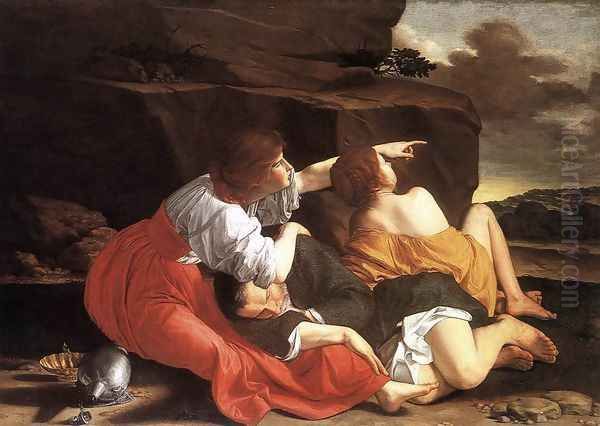
Following his success in Genoa, Gentileschi's reputation had grown internationally. In 1624, he traveled to Paris, invited by Queen Marie de' Medici, the widow of King Henry IV of France. He worked for the French court for about two years, contributing to the decoration of the Luxembourg Palace, though the specifics of his contributions are not entirely clear. His presence in Paris, however brief, would have brought his sophisticated Italian Baroque style directly to French artists. Figures like Simon Vouet, who himself had spent considerable time in Italy and absorbed Caravaggesque influences, were active in France, and Gentileschi's presence would have reinforced these trends.
The English Sojourn: Court Painter to Charles I
In 1626, Orazio Gentileschi embarked on the final and perhaps most prestigious phase of his career, moving to London at the invitation of George Villiers, 1st Duke of Buckingham, a key favorite of King Charles I. Soon after, he became a court painter to Charles I, a monarch renowned for his discerning taste and extensive art collection. This was a period of significant cultural flourishing in England, with the king actively patronizing artists from across Europe.
Gentileschi's most important commission in England was the series of nine ceiling paintings for the Great Hall of the Queen's House in Greenwich, designed by Inigo Jones for Queen Henrietta Maria, Charles I's wife. The central painting, An Allegory of Peace and the Arts under the English Crown (c. 1635-1638, now installed in Marlborough House, London), celebrated the flourishing of culture under royal patronage. These large-scale works demonstrate Gentileschi's ability to adapt his style to grand decorative schemes, employing lighter colors and more expansive compositions suitable for ceiling views.
During his time in London, he also produced easel paintings for the king and other courtiers. Notable works from this period include The Finding of Moses (c. 1630-1633, National Gallery, London, with another version in the Prado, Madrid). This painting is a superb example of his late style, characterized by elegant, elongated figures, rich, jewel-like colors, and a serene, almost pastoral mood. The landscape elements are more prominent, and the overall effect is one of courtly sophistication. Another work, Joseph and Potiphar's Wife (c. 1630-1632, Royal Collection Trust), tackles a dramatic biblical narrative with his characteristic blend of psychological tension and refined execution.
His daughter, Artemisia Gentileschi, also a highly accomplished painter, joined him in London around 1638, possibly to assist with the Queen's House commission and to pursue her own career at the English court. Orazio Gentileschi remained in London until his death in February 1639. He was buried in the Queen's Chapel, St James's Palace. His presence, along with that of other foreign artists like Anthony van Dyck (who became the leading court painter), significantly enriched the artistic landscape of Caroline England.
Artistic Style and Techniques: A Refined Caravaggism

Orazio Gentileschi's artistic style is best understood as a sophisticated and individualized interpretation of Caravaggism. He embraced Caravaggio's revolutionary use of chiaroscuro to model forms and create dramatic impact, but he tempered it with a greater sense of elegance and a more luminous palette.
Light and Shadow: While Caravaggio's tenebrism often involved impenetrable blacks and stark, almost brutal contrasts, Gentileschi's use of light was typically softer and more nuanced. His shadows are often transparent, allowing details to emerge, and his highlights are carefully controlled to create a sense of volume and texture without harshness. He masterfully used light to direct the viewer's eye and to enhance the emotional atmosphere of his scenes.
Color: Gentileschi was a superb colorist. His palette is characterized by rich, saturated hues—deep reds, vibrant blues, lustrous yellows, and subtle greens—often juxtaposed to create harmonious and visually appealing effects. He had a particular fondness for depicting luxurious fabrics like silks, satins, and velvets, and his skill in rendering their sheen and texture through subtle gradations of color and light was exceptional. This can be seen in works like The Lute Player (c. 1612-1620, National Gallery of Art, Washington D.C.).
Figure Style and Composition: Gentileschi's figures generally possess a greater sense of grace and idealization than Caravaggio's more ruggedly naturalistic characters. While grounded in observation from life, his figures are often elongated and elegant, displaying a refined sense of poise. His compositions are carefully constructed, often with a sense of classical balance, even when depicting dramatic moments. He avoided the crowded, tumultuous scenes favored by some Baroque artists, preferring clearer, more focused narratives.
Emotional Tone: The emotional tenor of Gentileschi's work is often one of quiet introspection, serene spirituality, or gentle lyricism. Even in dramatic subjects, there is a prevailing sense of restraint and dignity. This contrasts with the raw, often visceral emotional intensity found in Caravaggio's art or in the work of more overtly dramatic Caravaggisti like Jusepe de Ribera.
Orazio and Artemisia: A Complex Artistic Dynasty
The relationship between Orazio Gentileschi and his daughter, Artemisia Gentileschi (1593-c.1656), is one of the most fascinating and studied in art history. Artemisia was trained in her father's workshop and became one of the most important and celebrated female painters of the Baroque era, and indeed, of all time.

Orazio recognized his daughter's prodigious talent from an early age. She absorbed his techniques, including his refined Caravaggesque style, his meticulous attention to detail, and his skill in rendering textures. Her early works, such as Susanna and the Elders (1610, Schönborn Collection, Pommersfelden), created when she was only seventeen, demonstrate a remarkable precocity and a clear debt to her father's instruction.
However, their relationship was profoundly impacted by a traumatic event. In 1611, Artemisia was raped by Agostino Tassi, Orazio's collaborator. Orazio subsequently brought Tassi to trial in 1612, not primarily for the rape itself (which was then considered more a crime against family honor than against the individual woman), but for defiling his daughter and for reneging on a promise of marriage. The lengthy and humiliating trial, during which Artemisia was subjected to physical torture (thumbscrews, a method used to "verify" testimony), deeply affected her life and art. Tassi was convicted but received a relatively light punishment.
Following the trial, Artemisia moved to Florence, married, and established herself as an independent artist, becoming the first woman accepted into the prestigious Accademia delle Arti del Disegno. While her artistic foundations were laid by Orazio, Artemisia developed her own powerful and distinctive style. She often focused on strong female protagonists from myth and the Bible, such as Judith, Jael, and Cleopatra, depicting them with an unprecedented psychological depth and agency. Works like her various versions of Judith Slaying Holofernes are far more visceral and overtly violent than her father's interpretations of dramatic scenes, often interpreted by scholars as reflecting her personal trauma and resilience.
Despite their separate paths, Orazio and Artemisia maintained a connection. As mentioned, she joined him in London towards the end of his life. Their artistic dialogue, though complex and sometimes strained by personal history and professional rivalry, represents a unique instance of artistic transmission and evolution within a single family.
Contemporaries and Artistic Milieu
Orazio Gentileschi operated within a rich and competitive artistic landscape. In Rome, besides Caravaggio and his immediate circle (which included artists like Bartolomeo Manfredi, Carlo Saraceni, and Cecco del Caravaggio), there was the influential Bolognese school led by the Carracci family—Annibale, Agostino, and Ludovico Carracci. Their classicizing Baroque style offered an alternative to Caravaggio's dramatic naturalism. Other prominent Italian contemporaries included Guido Reni, Domenichino, and Guercino, all of whom forged significant careers.
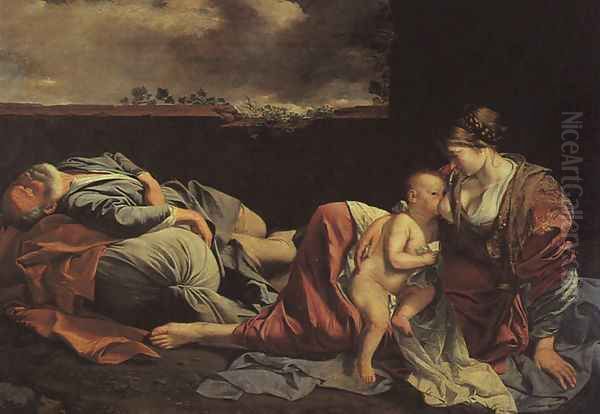
His travels brought him into contact with different artistic centers and patrons. In Genoa, he would have been aware of the impact of Flemish masters like Rubens and Van Dyck. In Paris, the court of Marie de' Medici was a hub of artistic activity, with French artists like Simon Vouet returning from Italy with their own interpretations of the Baroque. In London, Charles I's court was a magnet for talent, most notably Anthony van Dyck, whose elegant portraiture came to define the Caroline era. Gentileschi's ability to navigate these diverse environments and secure patronage speaks to his skill and adaptability.
Legacy and Re-evaluation
For a period after his death, Orazio Gentileschi's fame was somewhat eclipsed, partly by the more dramatic narrative surrounding Caravaggio and partly by the rising prominence of his own daughter, Artemisia, especially in modern feminist art history. However, scholarly research in the 20th and 21st centuries has led to a significant re-evaluation of his contributions.
Orazio Gentileschi is now recognized as a highly original artist who played a crucial role in the dissemination and interpretation of Caravaggesque painting. He was not merely an imitator but an innovator who infused Caravaggio's style with a unique lyricism, elegance, and chromatic brilliance. His international career helped to spread Italian Baroque aesthetics to France and England, influencing local artistic developments.
His paintings are prized for their technical mastery, their subtle psychological insights, and their sheer beauty. Works like The Annunciation, The Finding of Moses, and Saint Cecilia and an Angel are considered highlights of Baroque art. His influence on Artemisia is undeniable, providing her with the technical foundation upon which she built her own extraordinary career.
Exhibitions dedicated to his work and to the relationship between him and Artemisia have further solidified his reputation. He is seen as a bridge figure, connecting the revolutionary fervor of early Caravaggism with the more refined and courtly aesthetics that characterized later Baroque painting. His ability to create works of profound spiritual depth, dramatic intensity, and exquisite beauty ensures his enduring place in the pantheon of great Baroque masters. His art continues to captivate viewers with its luminous surfaces, rich colors, and the graceful humanity of his figures, a testament to a career dedicated to the pursuit of artistic excellence across Europe.